|
|
Home | Corson
Collection | Biography | Works | Image
Collection | Recent Publications | Portraits | Correspondence | Forthcoming
Events | Links | E-Texts | Contact
Scott the Novelist
Early Experiments
in Fiction
Scott had been an enthusiastic novel-reader since his school years
and had acquired not only an exhaustive knowledge of the English
novel tradition but extensive familiarity with the classics of
French, German, and Spanish fiction (see School
and University and Literary Beginnings).
According to his own account in the 'General Preface' to the 'Magnum
Opus' edition of the Waverley Novels (1829), Scott's first experiments
with prose fiction date from the turn of the nineteenth century.
Two fragments survive (published as appendices to the 'General
Preface'). Thomas the Rhymer was destined to be a 'tale
of chivalry' in the style of Horace Walpole's The Castle of
Otranto, 'with plenty of Border characters, and supernatural
incident'. The Lord of Ennerdale too was strongly influenced
by prevailing Gothic models such as Walpole, Anne Radcliffe, and
'Monk' Lewis. Neither work was carried beyond its first chapter.
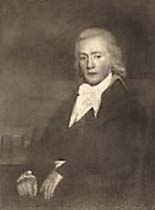 Scott
did not, though, abandon the ambition to write prose fiction. According
to the General Preface (1829) to the 'Magnum Opus' edition of the
Waverley Novels, he began work 'about the year 1805' on a novel
entitled 'Waverley, or 'tis Fifty Years Since', inspired by tales
heard from Jacobite veterans and by his own travels in the Highlands
as an apprentice Writer to the Signet (see Professional
Life). Scott was intrigued by the fictional potential of the
clash between the ancient, patriarchal customs of the Highlanders
and the march of progress in the increasingly industrialized age
of the Enlightenment. Having given the opening chapters to read
to his friend Will Erskine (portrayed, right), an unfavourable
reaction left Scott reluctant to risk the literary reputation newly
won by the success of The
Lay of the Last Minstrel (see Scott
the Poet). The fragment then lay forgotten in a drawer
until autumn 1813. Scott
did not, though, abandon the ambition to write prose fiction. According
to the General Preface (1829) to the 'Magnum Opus' edition of the
Waverley Novels, he began work 'about the year 1805' on a novel
entitled 'Waverley, or 'tis Fifty Years Since', inspired by tales
heard from Jacobite veterans and by his own travels in the Highlands
as an apprentice Writer to the Signet (see Professional
Life). Scott was intrigued by the fictional potential of the
clash between the ancient, patriarchal customs of the Highlanders
and the march of progress in the increasingly industrialized age
of the Enlightenment. Having given the opening chapters to read
to his friend Will Erskine (portrayed, right), an unfavourable
reaction left Scott reluctant to risk the literary reputation newly
won by the success of The
Lay of the Last Minstrel (see Scott
the Poet). The fragment then lay forgotten in a drawer
until autumn 1813.
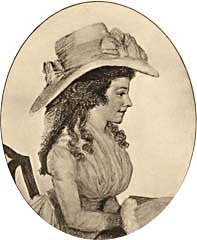 Recent
critics have queried the chronology of Scott's account, uncovering
compelling textual and circumstantial evidence that Scott was actively
engaged with the novel over the period 1808-10 and, indeed, may
not have begun work on it before that time (see the Waverley page
for the relevant arguments). They have also questioned Scott's
account (in the General Preface) of the literary influences that
led him to resume his experiment with fiction. The debt that Scott
acknowledges to Maria Edgeworth (portrayed, left) is unarguably
genuine. The success of her novels of Irish manners such as Castle
Rackrent and Ennui led Scott to believe that his countrymen
might be presented to the English novel-reading public 'in a more
favourable light than they had been placed hitherto, and tend to
procure sympathy for their virtues and indulgence for their foibles.'
Edgeworth would later become a valued correspondent of Scott and
acute reader of his novels. While acknowledging Edgeworth's influence,
however, Scott downplays that of other practitioners of the 'national
tale' or novel of regional manners such as Lady Morgan, Jane Porter,
and Elizabeth Hamilton. In so doing and in backdating the genesis
of Waverley to 1805, Scott's first novel thus appears
to pre-empt rather than respond to a literary mode. Recent
critics have queried the chronology of Scott's account, uncovering
compelling textual and circumstantial evidence that Scott was actively
engaged with the novel over the period 1808-10 and, indeed, may
not have begun work on it before that time (see the Waverley page
for the relevant arguments). They have also questioned Scott's
account (in the General Preface) of the literary influences that
led him to resume his experiment with fiction. The debt that Scott
acknowledges to Maria Edgeworth (portrayed, left) is unarguably
genuine. The success of her novels of Irish manners such as Castle
Rackrent and Ennui led Scott to believe that his countrymen
might be presented to the English novel-reading public 'in a more
favourable light than they had been placed hitherto, and tend to
procure sympathy for their virtues and indulgence for their foibles.'
Edgeworth would later become a valued correspondent of Scott and
acute reader of his novels. While acknowledging Edgeworth's influence,
however, Scott downplays that of other practitioners of the 'national
tale' or novel of regional manners such as Lady Morgan, Jane Porter,
and Elizabeth Hamilton. In so doing and in backdating the genesis
of Waverley to 1805, Scott's first novel thus appears
to pre-empt rather than respond to a literary mode.
A further influence, possibly overstated by Scott, was the editorial
work undertaken for John Murray on Joseph Strutt's unfinished romance
of fifteenth-century England Queenhoo-Hall (published 1808),
to which Scott added two concluding chapters of his own. Scott
attributed the commercial failure of Queenhoo-Hall to Strutt's
excessively archaic language and desire to vaunt his antiquarian
knowledge. He felt that it would be possible to write a historical
romance more readily comprehensible to the general reader but feared
there was little appetite for tales of medieval chivalry.The enthusiastic
public and critical response to the description of Highland landscape
and manners in Scott poem The
Lady of the Lake (1810) persuaded him that a prose narrative
of more recent history, with a Highland setting, might have a better
chance of success.
Back to top
Waverley
According to Scott's account in the 'General Preface' to the 'Magnum
Opus' edition of the Waverley Novels (questioned by some recent
critics and biographers), the Waverley manuscript was mislaid
during his move to Abbotsford in 1811.
One day in autumn 1813, however, Scott claims to have come across
the manuscript in a drawer while rummaging for fishing tackle.
He reread it, was persuaded that it had potential, and resolved
to complete it. He was bolstered in this resolution by the disappointing
sales of his recent narrative poem Rokeby and
the pressing financial difficulties of John
Ballantyne's publishing business, in which Scott was silent
half-partner (see Financial Hardship).
Consulted once again on the completion of the first volume, Will
Erskine reversed his original opinion, and warmly encouraged Scott.
The second and third volumes were completed in an extraordinary
three-week burst in June 1814, and Waverley (with
the subtitle updated to ''tis Sixty Years Since'), published
on 7 July, a few weeks before Scott's forty-third birthday.
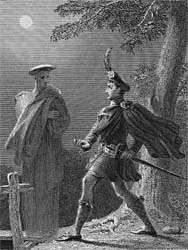 The
novel (illustrated, right) was published anonymously and, in order
to preserve Scott's incognito, the manuscript had been copied out
in John Ballantyne's hand before going to print. Scott's
novels would continue to be published anonymously or under pseudonyms
until 1827 when Scott admitted to his authorship at a public dinner.
Only those closest to Scott were let into the secret of his authorship,
though thousands more came to suspect it. There is no clear single
reason why Scott wished to remain anonymous, but a number of factors
contributed to his decision. Firstly, the novel was not considered
a serious genre at the time, especially in comparison with the
sort of narrative verse that Scott had hitherto published. Secondly,
writing fiction would not have been regarded as a decorous pastime
for a Clerk of the Session (see Professional
Life). Finally, Scott viewed the publication of Waverley as
an experiment upon the public taste and wished to protect his reputation
should the book fail. As time went on, though, and the Waverley
Novels became ever more popular, Scott's anonymity undoubtedly
also appealed to his taste for romance and mystery. The
novel (illustrated, right) was published anonymously and, in order
to preserve Scott's incognito, the manuscript had been copied out
in John Ballantyne's hand before going to print. Scott's
novels would continue to be published anonymously or under pseudonyms
until 1827 when Scott admitted to his authorship at a public dinner.
Only those closest to Scott were let into the secret of his authorship,
though thousands more came to suspect it. There is no clear single
reason why Scott wished to remain anonymous, but a number of factors
contributed to his decision. Firstly, the novel was not considered
a serious genre at the time, especially in comparison with the
sort of narrative verse that Scott had hitherto published. Secondly,
writing fiction would not have been regarded as a decorous pastime
for a Clerk of the Session (see Professional
Life). Finally, Scott viewed the publication of Waverley as
an experiment upon the public taste and wished to protect his reputation
should the book fail. As time went on, though, and the Waverley
Novels became ever more popular, Scott's anonymity undoubtedly
also appealed to his taste for romance and mystery.
|
|
Waverley was an astonishing success, the
first edition selling out within two days of publication. The
critics too were warm in their praise, particularly Francis
Jeffrey (portrayed, left) in the Edinburgh Review who
extolled its truth to nature, fidelity to 'actual experience',
force of characterization, and vivid description. Some reviewers,
though, notably John Wilson Croker for the Quarterly Review,
expressed reservations about the propriety of mixing history
and romance. Despite enduring critical doubts about its legitimacy
as a genre, Waverley marks the birth of the historical
novel in English. |
Back to top
The 'Scottish
Novels'
Over the next five years, Scott wrote a further eight novels set
in seventeenth- or eighteenth-century Scotland. It is substantially
upon these works that Scott's critical reputation now rests. Guy
Mannering (1815) and The
Antiquary (1816), Scott's own favourite amongst his novels,
complete, with Waverley, an ideal trilogy illustrating three
periods of Scottish history from the 1740s to the 1800s. Each volume
brought further commercial success. Critical opinion was broadly
favourable though there was the first hint of charges that would
be regularly leveled at Scott's future novels: that he repeated
his characters under different names, failed to make his Scots
dialogue sufficiently comprehensible for an English audience, relied
excessively on the supernatural, or was irreverent in matters of
religion.
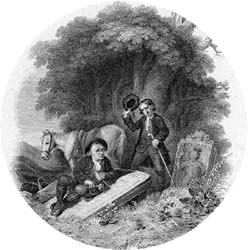 For
his next publication Scott made a further attempt to mystify the
public, adopting the nom de plume of Jedediah Cleishbotham,
schoolmaster at the fictional village of Gandercleuch. Cleishbotham
purported to be editing the narratives of one Peter Pattieson which
in turn were supposed to be based on stories told by the landlord
of the local inn. As the volume was to be published by Blackwood
rather than Constable, Scott hoped that the public would believe
a new writer had appeared to challenge the supremacy of the 'Author
of Waverley'. Tales of My Landlord (1816) was originally
to consist of four short novels on Scottish regional themes. However, The
Tale of Old Mortality, set during the anti-Covenanting
campaign of John Graham of Claverhouse, grew to fill three volumes,
and of the other stories, only The
Black Dwarf was completed and published along with it.
The Tales matched the commercial success of the earlier
trilogy, and critics concurred with Scott's own assessment that Old
Mortality (illustrated, above right) was his best work to date.
They equally, however, shared Scott's view that The Black Dwarf,
a tale of family rivalry in early eighteenth-century Scotland,
retrod old ground. For
his next publication Scott made a further attempt to mystify the
public, adopting the nom de plume of Jedediah Cleishbotham,
schoolmaster at the fictional village of Gandercleuch. Cleishbotham
purported to be editing the narratives of one Peter Pattieson which
in turn were supposed to be based on stories told by the landlord
of the local inn. As the volume was to be published by Blackwood
rather than Constable, Scott hoped that the public would believe
a new writer had appeared to challenge the supremacy of the 'Author
of Waverley'. Tales of My Landlord (1816) was originally
to consist of four short novels on Scottish regional themes. However, The
Tale of Old Mortality, set during the anti-Covenanting
campaign of John Graham of Claverhouse, grew to fill three volumes,
and of the other stories, only The
Black Dwarf was completed and published along with it.
The Tales matched the commercial success of the earlier
trilogy, and critics concurred with Scott's own assessment that Old
Mortality (illustrated, above right) was his best work to date.
They equally, however, shared Scott's view that The Black Dwarf,
a tale of family rivalry in early eighteenth-century Scotland,
retrod old ground.
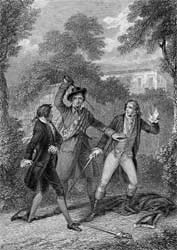 |
Few readers or reviewers were taken in by the
pseudonym of Cleishbotham, perceiving self-evident similarities
between the style of Tales of My Landlord and that of
the 'author of Waverley'. Nonetheless, in crediting his next
novel Rob Roy (1817)
to the latter, and reverting to Constable as a publisher, Scott
was diverted by the idea of bringing his two noms de plume into
direct competition. Rob Roy (illustrated, left) , a
tale of the Jacobite Rebellion of 1715, was a further critical
and commercial triumph, the original print run of 10,000, a
huge figure for the time, being bought up in two weeks. It
remains to this day among Scott's most widely read and translated
novels. The fortune of Scott's novels had by now eclipsed that
of his increasingly unsuccessful verse narratives. 1817 saw
the publication of Scott's final long poem, Harold
the Dauntless . Hereafter, he would work predominantly
in prose. |
| Scott remained with Constable for
the Second Series of Tales of My Landlord (1818), finding
that he promoted his work more efficiently than Blackwood.
The four-volume Second Series, again credited to Cleishbotham,
was entirely taken up by The
Heart of Midlothian (illustrated, right), inspired
by Helen Walker's eighteenth-century journey to London to obtain
a pardon for her sister on a charge of child-murder. Now widely
regarded as Scott's finest novel, it initially encountered
a lukewarm critical response, with the fourth volume being
generally perceived as superfluous. The public, however, remained
faithful. |
|
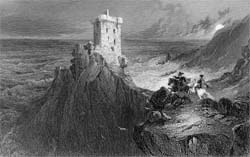 A
Third Series of Tales of My Landlord appeared in 1819. Written
when Scott was critically ill, The
Bride of Lammermoor (illustrated, left) was a return to
the world of the Border ballads. One of the few Scott novels to
have a tragic conclusion, its tale of foredoomed love immediately
caught the public imagination. It inspired many artists and gave
rise to numerous stage and musical adaptations, most famously Donizetti's Lucia
di Lammermoor. Its companion-piece A
Legend of Montrose, set during the Royalist Earl of Montrose's
Highland campaign against the Covenanters in 1644, has remained
somewhat in its shadow. Its mercenary anti-hero, Captain Dalgetty,
however has since been recognized as one of Scott's finest comic
characters. A
Third Series of Tales of My Landlord appeared in 1819. Written
when Scott was critically ill, The
Bride of Lammermoor (illustrated, left) was a return to
the world of the Border ballads. One of the few Scott novels to
have a tragic conclusion, its tale of foredoomed love immediately
caught the public imagination. It inspired many artists and gave
rise to numerous stage and musical adaptations, most famously Donizetti's Lucia
di Lammermoor. Its companion-piece A
Legend of Montrose, set during the Royalist Earl of Montrose's
Highland campaign against the Covenanters in 1644, has remained
somewhat in its shadow. Its mercenary anti-hero, Captain Dalgetty,
however has since been recognized as one of Scott's finest comic
characters.
Back to top
From Ivanhoe to
The Talisman
| Scott's next novel marked his first fictional
excursion outside the bounds of Scotland. Ivanhoe (1820),
set in twelfth-century England, was published under a new pseudonym
Laurence Templeton, which again fooled almost no-one. The novel
(illustrated, right) rapidly became an international phenomenon,
launching Scott's continental vogue and providing the blueprint
for the historical novel across Europe. In Britain, it played
a major role in sparking the nineteenth-century fascination
for all things medieval. |
|
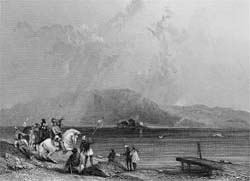 Nonetheless,
Scott did not immediately seek to replicate the success of Ivanhoe with
another chivalric romance. His next two novels returned to a Scottish
setting. The Monastery and
its sequel The Abbot (both
1820) were set in the reign of Mary, Queen of Scots. If the former
disappointed many readers (including Scott himself), the latter,
dealing with Mary's escape from imprisonment, fully restored his
reputation. Its success helped Scott overcome his initial misgivings
about his ability to inhabit the sixteenth-century imaginatively,
and his next novel Kenilworth (1821)
was set in Elizabethan England. Scott, by this stage, was writing
at a feverish rate, and before the end of 1821 had published a
further novel, The Pirate,
set in early seventeenth-century Shetland and Orkney. Excluded
from the relatively limited twentieth-century Scott canon, The
Abbot and The Pirate remained amongst Scott's most popular
works throughout the nineteenth-century, providing source material
for many Victorian artists, and inspiring tourist pilgrimages to
Loch Leven (portrayed, above left) and the Northern Isles. Kenilworth too
was a major European success and, long dismissed as a succession
of historical tableaux, has recently enjoyed a critical revival. Nonetheless,
Scott did not immediately seek to replicate the success of Ivanhoe with
another chivalric romance. His next two novels returned to a Scottish
setting. The Monastery and
its sequel The Abbot (both
1820) were set in the reign of Mary, Queen of Scots. If the former
disappointed many readers (including Scott himself), the latter,
dealing with Mary's escape from imprisonment, fully restored his
reputation. Its success helped Scott overcome his initial misgivings
about his ability to inhabit the sixteenth-century imaginatively,
and his next novel Kenilworth (1821)
was set in Elizabethan England. Scott, by this stage, was writing
at a feverish rate, and before the end of 1821 had published a
further novel, The Pirate,
set in early seventeenth-century Shetland and Orkney. Excluded
from the relatively limited twentieth-century Scott canon, The
Abbot and The Pirate remained amongst Scott's most popular
works throughout the nineteenth-century, providing source material
for many Victorian artists, and inspiring tourist pilgrimages to
Loch Leven (portrayed, above left) and the Northern Isles. Kenilworth too
was a major European success and, long dismissed as a succession
of historical tableaux, has recently enjoyed a critical revival.
Scott maintained his phenomenal rate of production
with The Fortunes of Nigel in
May 1822 and Peveril of
the Peak in January 1823. With these works he returned
to the seventeenth century. The former is set shortly after the
Union of the Crowns and traces the efforts of a Scottish nobleman
to protect his inheritance at the court of King James VI and I.
The latter deals with the so-called Popish Plot of 1678. Although
Scott retained his popularity with the reading public, critical
opinion was by now divided. Increasingly, Scott was charged with
over-hasty composition, careless plotting, and the duplication
of characters and situations. Reviewers repeatedly insinuated that
he was now writing less for fame than fortune.
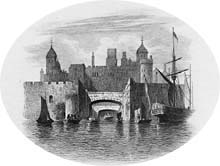 Two
further novels appeared in 1823. Quentin
Durward, set in fifteenth-century France, was Scott's first
fictional venture onto the continent of Europe. Despite being his
most critically acclaimed work since Ivanhoe, sales were
slow. Scott and his publishers began to fear that they were glutting
the market and that the public were struggling to believe that
the 'Author of Waverley' could be solely responsible for such a
rapid succession of novels. In stark contrast, Quentin Durward (illustrated,
above right) caused a similar sensation in France to Waverley in
Scotland and Ivanhoe in England. The vogue for the novel
subsequently spread across Europe, eventually awakening renewed
interest in Britain. Although it has fallen out of critical favour
in the English-speaking world, it remains one of Scott's most translated
works. Scott's next work St.
Ronan's Well, published after a tactical pause in December
1823, was another bold departure. His only work with a nineteenth-century
setting, it portrays the domestic tragedies and comedies of a small
Scottish spa-town and bears testimony to Scott's admiration for
Jane Austen. It was perhaps Scott's least favourably reviewed novel,
with critics censuring Scott for 'descending' to a lesser genre
befitting only mediocre talents. Two
further novels appeared in 1823. Quentin
Durward, set in fifteenth-century France, was Scott's first
fictional venture onto the continent of Europe. Despite being his
most critically acclaimed work since Ivanhoe, sales were
slow. Scott and his publishers began to fear that they were glutting
the market and that the public were struggling to believe that
the 'Author of Waverley' could be solely responsible for such a
rapid succession of novels. In stark contrast, Quentin Durward (illustrated,
above right) caused a similar sensation in France to Waverley in
Scotland and Ivanhoe in England. The vogue for the novel
subsequently spread across Europe, eventually awakening renewed
interest in Britain. Although it has fallen out of critical favour
in the English-speaking world, it remains one of Scott's most translated
works. Scott's next work St.
Ronan's Well, published after a tactical pause in December
1823, was another bold departure. His only work with a nineteenth-century
setting, it portrays the domestic tragedies and comedies of a small
Scottish spa-town and bears testimony to Scott's admiration for
Jane Austen. It was perhaps Scott's least favourably reviewed novel,
with critics censuring Scott for 'descending' to a lesser genre
befitting only mediocre talents.
| The reviewers were scarcely more enthusiastic
about 1824's Redgauntlet (illustrated,
left). Now regarded as amongst the finest of the Waverley novels,
its mixture of epistolary and narrative sequences was widely
seen as a throwback to the conventions of the eighteenth-century
novel. Set during a fictional late eighteenth-century Jacobite
Rebellion in the Border region, it is among Scott's most autobiographical
works, containing echoes of his apprenticeship to the Law (see Professional
Life) and an affectionate caricature of his father (see Family
Background). It was one of Scott's personal favourites
amongst his novels. |
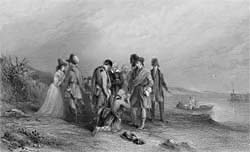 |
The critics were relieved to see Scott return to
the high Middle Ages with Tales of the Crusaders (1825).
Scott here united two novels, The
Talisman, set in Palestine during the Third Crusade, and The
Betrothed, a tale of border conflicts between Anglo-Norman
and Welsh barons. Featuring Saladin and Richard the Lionheart in
prominent roles, the former gave rise to further debate on the
propriety of mingling historical facts and personages with fiction.
As Scott and his publishers had hoped, though, its virtues nonetheless
distracted critics and public from the shortcomings of its companion
piece. Particularly in Europe, The Talisman remains a highly
popular novel, though largely promoted as a work for children.
Back to top
After the Crash
| The winter of 1825-26 saw the economic recession
which led to the ruin of his publishers and to Scott's own
insolvency (see Financial hardship).
A further blow came in May 1826 with the death of Scott's wife Charlotte.
Begun before the crisis, Scott's next novel Woodstock (illustrated,
right) set during the English Civil War, was hurriedly
completed to answer pressing financial necessities. There were
renewed rumblings among the critics (unaware of the full extent
of Scott's difficulties) that Scott was writing for profit
alone but the novel sold well both north and south of the border. |
|
As Scott fought to pay off his debts during the last
six years of his life, his fictional production dropped off. His
creative energy was primarily expended on the biography of Napoleon (1827-8)
and the lucrative Tales
of a Grandfather (1828-31) and History of Scotland (1829).
He nonetheless published four further volumes of fiction. Chronicles
of the Canongate (1827) was credited to a new nom de
plume, Mr. Chrystal Croftangry, and contained two short-stories: 'The
Highland Widow', and 'The
Two Drovers', and a novella, 'The
Surgeon's Daughter'. Despite lukewarm reviews, Scott considered
the two short stories among his finest work, an opinion shared
by many recent critics. The Second Series of Chronicles of the
Canongate was composed entirely of the novel The
Fair Maid of Perth (1828). Set in late fourteenth-century
Scotland, it was Scott's last major commercial and critical success
as a writer of fiction.
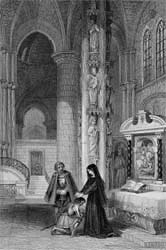 Scott
returned to the fifteenth-century dynastic quarrels of Quentin
Durward for his next novel Anne
of Geierstein (1829) (illustrated, left). To his surprise,
it was relatively well received by both public and critics, though
some of the latter shared his own opinion that the factual elements
of the plot were more interesting than the purely fictional. Finally,
in December 1831, ten months before Scott's death, his last two
novels Count Robert of
Paris and Castle
Dangerous were published together as a Fourth Series of Tales
of My Landlord. The former was set in Byzantium during the
First Crusade, the latter in the Scottish Borders during the Wars
of Independence. Although Scott barely considered them 'seaworthy',
the public remained faithful. Critical reaction was uneffusive
but largely respectful, though subsequent commentators regarded
them as the weakest part of Scott's oeuvre. Scott
returned to the fifteenth-century dynastic quarrels of Quentin
Durward for his next novel Anne
of Geierstein (1829) (illustrated, left). To his surprise,
it was relatively well received by both public and critics, though
some of the latter shared his own opinion that the factual elements
of the plot were more interesting than the purely fictional. Finally,
in December 1831, ten months before Scott's death, his last two
novels Count Robert of
Paris and Castle
Dangerous were published together as a Fourth Series of Tales
of My Landlord. The former was set in Byzantium during the
First Crusade, the latter in the Scottish Borders during the Wars
of Independence. Although Scott barely considered them 'seaworthy',
the public remained faithful. Critical reaction was uneffusive
but largely respectful, though subsequent commentators regarded
them as the weakest part of Scott's oeuvre.
Perhaps, though, Scott's greatest literary commitment
in the last years of his life was in revising his fiction for the
'Magnum Opus' edition of the Waverley Novels published from 1829
onwards. In addition, Scott wrote lengthy introductions to each
volume and added copious contextual notes. The 'Magnum Opus' remained
the standard edition of Scott throughout the Victorian period and
its critical status has only recently been challenged by the Edinburgh
Edition (see Recent Publications).
Back to top
- For further details of all of the novels discussed
on this page (compositional history, plot summary, reception
by contemporary critics and readers) follow the links on the Works page.
- For e-texts of the novels discussed on this
page (from external providers), click here.
Back to Biography Index
Last updated: 23-Jan-2007
© Edinburgh University Library
|
|

 Scott
did not, though, abandon the ambition to write prose fiction. According
to the General Preface (1829) to the 'Magnum Opus' edition of the
Waverley Novels, he began work 'about the year 1805' on a novel
entitled 'Waverley, or 'tis Fifty Years Since', inspired by tales
heard from Jacobite veterans and by his own travels in the Highlands
as an apprentice Writer to the Signet (see
Scott
did not, though, abandon the ambition to write prose fiction. According
to the General Preface (1829) to the 'Magnum Opus' edition of the
Waverley Novels, he began work 'about the year 1805' on a novel
entitled 'Waverley, or 'tis Fifty Years Since', inspired by tales
heard from Jacobite veterans and by his own travels in the Highlands
as an apprentice Writer to the Signet (see  Recent
critics have queried the chronology of Scott's account, uncovering
compelling textual and circumstantial evidence that Scott was actively
engaged with the novel over the period 1808-10 and, indeed, may
not have begun work on it before that time (see the
Recent
critics have queried the chronology of Scott's account, uncovering
compelling textual and circumstantial evidence that Scott was actively
engaged with the novel over the period 1808-10 and, indeed, may
not have begun work on it before that time (see the  The
novel (illustrated, right) was published anonymously and, in order
to preserve Scott's incognito, the manuscript had been copied out
in John Ballantyne's hand before going to print. Scott's
novels would continue to be published anonymously or under pseudonyms
until 1827 when Scott admitted to his authorship at a public dinner.
Only those closest to Scott were let into the secret of his authorship,
though thousands more came to suspect it. There is no clear single
reason why Scott wished to remain anonymous, but a number of factors
contributed to his decision. Firstly, the novel was not considered
a serious genre at the time, especially in comparison with the
sort of narrative verse that Scott had hitherto published. Secondly,
writing fiction would not have been regarded as a decorous pastime
for a Clerk of the Session (see
The
novel (illustrated, right) was published anonymously and, in order
to preserve Scott's incognito, the manuscript had been copied out
in John Ballantyne's hand before going to print. Scott's
novels would continue to be published anonymously or under pseudonyms
until 1827 when Scott admitted to his authorship at a public dinner.
Only those closest to Scott were let into the secret of his authorship,
though thousands more came to suspect it. There is no clear single
reason why Scott wished to remain anonymous, but a number of factors
contributed to his decision. Firstly, the novel was not considered
a serious genre at the time, especially in comparison with the
sort of narrative verse that Scott had hitherto published. Secondly,
writing fiction would not have been regarded as a decorous pastime
for a Clerk of the Session (see 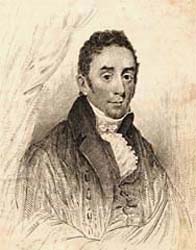
 For
his next publication Scott made a further attempt to mystify the
public, adopting the nom de plume of Jedediah Cleishbotham,
schoolmaster at the fictional village of Gandercleuch. Cleishbotham
purported to be editing the narratives of one Peter Pattieson which
in turn were supposed to be based on stories told by the landlord
of the local inn. As the volume was to be published by Blackwood
rather than Constable, Scott hoped that the public would believe
a new writer had appeared to challenge the supremacy of the 'Author
of Waverley'. Tales of My Landlord (1816) was originally
to consist of four short novels on Scottish regional themes. However,
For
his next publication Scott made a further attempt to mystify the
public, adopting the nom de plume of Jedediah Cleishbotham,
schoolmaster at the fictional village of Gandercleuch. Cleishbotham
purported to be editing the narratives of one Peter Pattieson which
in turn were supposed to be based on stories told by the landlord
of the local inn. As the volume was to be published by Blackwood
rather than Constable, Scott hoped that the public would believe
a new writer had appeared to challenge the supremacy of the 'Author
of Waverley'. Tales of My Landlord (1816) was originally
to consist of four short novels on Scottish regional themes. However, 
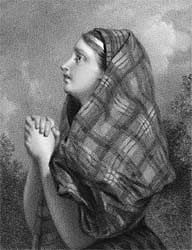
 A
Third Series of Tales of My Landlord appeared in 1819. Written
when Scott was critically ill,
A
Third Series of Tales of My Landlord appeared in 1819. Written
when Scott was critically ill, 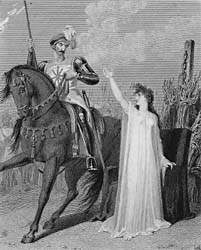
 Nonetheless,
Scott did not immediately seek to replicate the success of Ivanhoe with
another chivalric romance. His next two novels returned to a Scottish
setting. The
Nonetheless,
Scott did not immediately seek to replicate the success of Ivanhoe with
another chivalric romance. His next two novels returned to a Scottish
setting. The  Two
further novels appeared in 1823.
Two
further novels appeared in 1823. 

 Scott
returned to the fifteenth-century dynastic quarrels of Quentin
Durward for his next novel
Scott
returned to the fifteenth-century dynastic quarrels of Quentin
Durward for his next novel